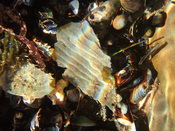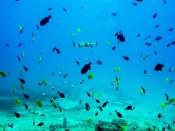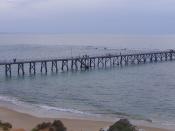Port Noarlungareef should essentially remain a reserve and not endangered by vile acts by humans. The unique Reef has been established for over 36 years, and is also one of Adelaide's main attractions. Therefore it has a right to be free of endangerment.
Port Noarlunga Reef was established in 1971, on the eastern side of Gulf St Vincent. This narrow reef was known to be formed from a sand dune; thus, a sandstone reef. The reef is 1.6km long, lying 400m offshore. Although permitted activities such as fishing are allowed, it is only permitted within a certain area of the reef where the organisms aren't endangered. This is why the reef is divided into two separate regions for the organism's protection. The reserve is inhabited with various heterotrophs and autotrophs within different parts of the reef: The algal-mussel community (black mussel, Coralline) are occupied by the flat reef top area.
The kelp plants occupy the outer reef slope area. Brown algae occupy the inside edge of the reef. Sponges, hydroids, and molluscs also inhabit various reef regions, as well as reef fish.
The ecosystem of the reef is fairly straight forward. The main energy source for the producers of the reef (Algae, Kelp, and Plankton) is sunlight and water which provide them with nutrients. The producers provide resourceful energy for organisms (Warreners, Elephant Snail, and Sea Urchin), in order for them to survive. These organisms are eaten by the marine carnivore organisms (Common Sea Star, Dog Winkle) for sufficient energy. Birds and Fish gain their energy by obtaining most of these heterotrophs and autotrophs. The characteristics of the ecosystem play a big part in order for the ecosystem to survive.
Port Noarlunga reef should retain as a sanctuary. This reserve is unique to Adelaide. Jakon Johan States "Reefs comprise...


